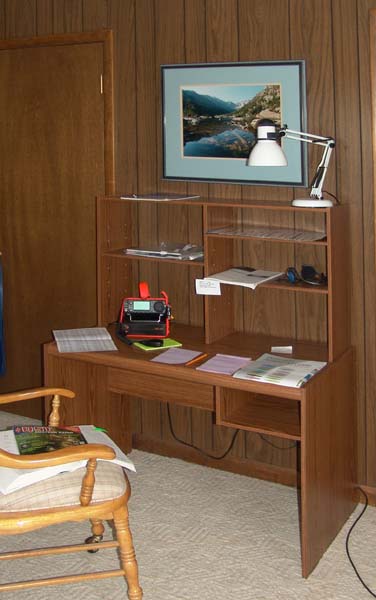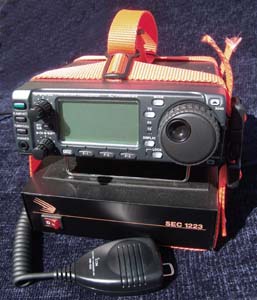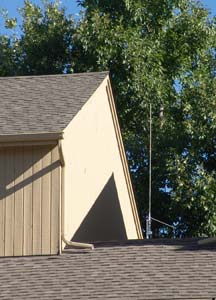|
In late 2004 I looked for an activity at home to
keep me busy during times when I would not be able to fly. Joan had
started to take helicopter lessons and outside at the airport it was too cold to work at
the unheated hangar on the Kitfox, which of course asked for some maintenance
here and there. Amateur Radio or HAM Radio as some call it had been on my
list of future interests. So why not !! I got the necessary books and CD and
started to pile the rules and regulations into my head. I was delighted that
I could refresh some of my math skills that had been dormant since my
University times.
For
the Technician License, the first test did not need the Morse or Code
skill. However, why not get it all done while I am at it? After all, in my
teen years I had been pretty good at it. Now, what I could remember? So I started
to train my brain to work faster and faster on that search routine to
recognize the letters out of the stream of dots and dashes or "DITs" and
"DAHs".
At some moments I felt like my head was going to explode and the steady
stream of signals was more perceived as a torrential rain soaking all my
senses.
To get the feel for what I was getting into, I decided
to take the first two exams after about a month of studying. They were given
by the local Radio Amateur Club once a month. I found out that it was a very
nice group of enthusiasts that happily encouraged you to come along and take
part in the fun this activity is offering. I passed the two
written entry tests and thus was proudly issued my official call sign.
|
|
Encouraged by the success
I kept working on the next two tests, one of them being the Morse Code which
I had to pass demonstrating the ability to copy at a speed of 5 words per
minute. Every free minute I sat down and listened to test transmissions.
AA9PW offered, for my taste, a very good entry program. However I found it
very difficult to advance from 3 to 5 words a minute and especially when
introducing the punctuations and extra signs besides the normal letters and
numbers. I tried to develop all sorts of helps to span this bridge. An old
HAM from our aviation electronics shop encouraged me to keep working. It is
all a question of time. There are no short cuts. The brain just has to
transition from the "recognition on demand" to the "automatic" search and
recognition routine. Well, shortly before our departure to Switzerland I
took those last two exams and to my own surprise, I PASSED !
With the FCC license as an Extra Class Radio Amateur in my pocket Joan and I
flew to Switzerland for a brief stop before going on to Australia.
Immediately I submitted my US license to the Swiss government and to my
great surprise I shortly thereafter was issued my Swiss license with the
call sign HB9TTI.
The next step was to go
online and check whether there was a US call sign with similar lettering
available. As luck had it, I found KB9TTI available. Through the Vanity
call sign change program it was an easy task to change the originally issued
US call sign to the new one I selected - KB9TTI. |
|
 The
next step after returning to the US ending our long trip through Western
Australia, was to put up an antenna. Our house in the mountains at the foot of Longs
Peak had an old TV antenna on the roof. As we had changed to a dish antenna
several years ago, this relic from last century was just waiting to be
removed. Using my cattle rope as safety line, I performed the exchange in
no time and had the Diamond X-50A 2m / 70cm antenna sticking into the wind.
All that was now needed was a transceiver. The
next step after returning to the US ending our long trip through Western
Australia, was to put up an antenna. Our house in the mountains at the foot of Longs
Peak had an old TV antenna on the roof. As we had changed to a dish antenna
several years ago, this relic from last century was just waiting to be
removed. Using my cattle rope as safety line, I performed the exchange in
no time and had the Diamond X-50A 2m / 70cm antenna sticking into the wind.
All that was now needed was a transceiver.
It was interesting to do
the research on the Internet, in the magazines and by talking to other
Amateur Radio guys. The final step was a trip to the Ham Radio Outlet in
downtown Denver. There were the experts who had the feel of the market and
I felt happy when I finally walked out of the shop with an ICOM
IC-706MK IIG.
|
|
 Unpacking
my IC-706 was one thing, but studying and applying the operating instructions
was another. There are so many features and possibilities of settings, that it
took me a while, Unpacking
my IC-706 was one thing, but studying and applying the operating instructions
was another. There are so many features and possibilities of settings, that it
took me a while, but
not without help from Bob (W0LMA). As I intended to move to various
locations I decided to bundle the IC-706 together with the power supply
using nice little straps. In addition we happened to stumble across a neat
little desk that served as a starting point for the communication area in our
house. but
not without help from Bob (W0LMA). As I intended to move to various
locations I decided to bundle the IC-706 together with the power supply
using nice little straps. In addition we happened to stumble across a neat
little desk that served as a starting point for the communication area in our
house.
On
a quiet evening I tried my first contact. Surprisingly, I found excellent
reception and communication to the south and southwest on the 2 meter
repeater connections. Living at 9000 ft, close to Allenspark, Colorado,
definitely had its advantages. Tapping into the vast knowledge of our new
friends, Ellie and Rip (NV�M), I am already planning to make use of those
natural towers around the house and install a dipole to allow some work on
the 60 to 10 meter bands. This will give me the opportunity to improve my CW
code skill, which at the moment is close to not really existent.
|
Next episode on my learning curve was the
installation of an antenna at our Boulder residence. While up in the
mountains no one was judging my choice of type and location of antennas,
but here in our tightly controlled environment, anyone who loves a challenge,
bickers
 about
any changes made in our small neighborhood. The Architectural Committee then
serves as the amplifier, the last stage before the burp is broadcasted.
Already in spring, anticipating ample time of assessing and digesting, I had
unofficially circulated some photo collages on possible antenna sizes and
mountings. Now in summer I was kindly informed, that with all the liberation
of free choice of communication, they, the Committee, would refrain from
requesting a project submission. HOWEVER, the large 24 ft antenna would be
out of the question and a small variety would have to be hidden behind part
of the wooden front structure holding the chimneys. I could not accept this, as the antenna I had chosen was taller than the
structure and the antenna feed would have been excessively long. I told
them I would study the proposition. about
any changes made in our small neighborhood. The Architectural Committee then
serves as the amplifier, the last stage before the burp is broadcasted.
Already in spring, anticipating ample time of assessing and digesting, I had
unofficially circulated some photo collages on possible antenna sizes and
mountings. Now in summer I was kindly informed, that with all the liberation
of free choice of communication, they, the Committee, would refrain from
requesting a project submission. HOWEVER, the large 24 ft antenna would be
out of the question and a small variety would have to be hidden behind part
of the wooden front structure holding the chimneys. I could not accept this, as the antenna I had chosen was taller than the
structure and the antenna feed would have been excessively long. I told
them I would study the proposition. |
|
 Reviewing the situation I decided to work on
reducing the visibility and started to spray paint the Diamond X-200A antenna in
a camouflage
pattern. Then I would try to use the branches of the lush trees in the
back of the house to conceal the appearance. Also at that location, the
distance to my shack in the basement would be much shorter. As the chief of the committee
stopped by some time later, I was surprised that he was happy with the
solution. I have the suspicion that he had anticipated major complications
with this project. Reviewing the situation I decided to work on
reducing the visibility and started to spray paint the Diamond X-200A antenna in
a camouflage
pattern. Then I would try to use the branches of the lush trees in the
back of the house to conceal the appearance. Also at that location, the
distance to my shack in the basement would be much shorter. As the chief of the committee
stopped by some time later, I was surprised that he was happy with the
solution. I have the suspicion that he had anticipated major complications
with this project.So, now I have my
station down in the valley in the midst of the city as well. The handy
little IC-706 accompanies me on my periodic migration. |


![]()